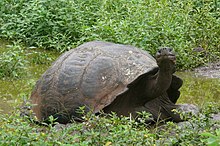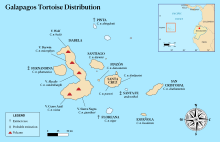加拉帕戈斯象龟
| 加拉帕戈斯象龟 | |
|---|---|

| |
| 栖息于圣克鲁斯岛上的加拉巴哥象龟。 | |
| 科学分类 | |
| 界: | 动物界 Animalia |
| 门: | 脊索动物门 Chordata |
| 纲: | 爬行纲 Reptilia |
| 目: | 龟鳖目 Testudines |
| 亚目: | 曲颈龟亚目 Cryptodira |
| 科: | 陆龟科 Testudinidae |
| 属: | 南美象龟属 Chelonoidis |
| 种: | 加拉帕戈斯象龟 C. nigra
|
| 二名法 | |
| Chelonoidis nigra | |
| 亚种 | |
| |

| |
| 异名[15] | |
|
亚种异名[7]
亚种异名 (概要)[12] C. n. nigra (指名亚种)
C. n. abingdoni
C. n. becki
C. n. chathamensis
C. n. darwini
C. n. duncanensis
C. n. hoodensis
C. n. phantastica
C. n. porteri
C. n. vicina 亚种异名 (全部)[15]
| |
加拉巴哥象龟(学名:Chelonoidis nigra)是现存体型最大的陆龟之一。为厄瓜多加拉巴哥群岛特有。成年象龟身长1.5 米(4.9呎),平均体重达到175公斤,最高纪录为400公斤(880磅),在爬虫类中列第13位。野外寿命超过100年。2006年6月23日在澳洲动物园因心脏衰竭病逝的大象龟哈丽,估计享年约175岁,病逝前为世上最长寿的存活动物。
由于加拉帕戈斯群岛中不同岛上的生态环境有明显的差异,故不同亚种的象龟形态都不同。在湿润的高地岛,象龟更大,有半球形的壳和短脖子,在干燥的低地岛,象龟更小,有马鞍形的壳和长脖子。这启发出达尔文对“演化论”的思考。
近年这些群岛上各品种之间的关系存在争议,故现时将加拉帕戈斯象龟归类为一个物种综合(species complex),而非单一物种。
16世纪加拉巴哥象龟的数量大约有25万只,1970年代只剩下3000只,主要原因是人的捕猎以获取肉和油,栖息地被农业生产占用和物种入侵,如羊和猪。原有的15个亚种还剩十个亚种在野外生存,第十一个亚种只剩一只名为“孤独乔治”的雄龟,于2012年6月死亡。20世纪初开始的动物保护活动使象龟现有的数量回复到1.9万只。在国际自然保护联盟名录中属于易危物种。
分布与栖息地
[编辑]
加拉帕戈斯象龟只分布于南美洲加拉帕戈斯群岛的9个小岛上。为适应各岛上不同的环境以及食物来源,象龟在数百万年间分化成15个亚种,现在仅约10种还有野外存活的个体,最近绝种的品种平塔岛象龟(C. n. abingdoni)曾长期只剩一只名为“孤独乔治”的雄龟。加拉巴戈斯国家公园(Galapagos National ParkService)于2012年6月24日发出声明,“孤独乔治”已经死亡。在6月24号当日,长久以来一直照顾“孤独乔治”的勒里纳(Fausto Llerena)发现它的尸体瘫在地上,面朝圣克鲁斯岛(Santa Cruz Island)上“它水坑的所在方向”。[16]
品种列表
[编辑]| 品种 [17][18] | 保育状况 |
|---|---|
| C. abingdonii 平塔岛象龟 |
|
| C. becki (named for Rollo Beck) 沃尔夫火山象龟(来自伊莎贝拉岛) |
 |
| C. chathamensis 圣克里斯托巴尔岛象龟 |
 |
| C. darwini (以查尔斯·达尔文命名) 圣地亚哥岛象龟 |
 |
| C. duncanensis 平松岛象龟 |
 |
| C. donfaustoi 加拉帕戈斯·唐福斯托象龟(分布在圣克鲁斯岛东部) |
未知,现存约250只;于2015年获确认为新种 |
| C. guentheri (以阿尔伯特·甘瑟命名) 内格拉火山象龟(来自伊莎贝拉岛) |
 |
| C. hoodensis 艾斯潘诺拉岛(西班牙岛)象龟 |
 |
| C. microphyes (L. 'small in stature') 达尔文火山象龟(来自伊莎贝拉岛) |
 |
| C. nigra (L. 'black') 弗雷里安纳岛象龟 |
1846年被宣布绝种 |
| C. phantasticus 费尔南迪纳巨龟(分布在费尔南迪纳岛) |
 极危;于2019年重新被发现 |
| C. porteri 圣克鲁斯岛象龟 |
 |
| C. vandenburghi
阿尔塞多火山象龟(来自伊莎贝拉岛)
|
 |
| C. vicina (L. 'near') 阿苏尔火山象龟(来自伊莎贝拉岛)
|
 |
习性
[编辑]龟是变温动物,因此在阳光下晒1-2小时,吸收太阳的热量,而天亮后他们会透过爬树积极觅食。它们每天睡8-9小时,大多在清晨或傍晚休息。同时,它们的行走速度为每小时0.3公里(0.2英里)。
在较大、较潮湿及低海拔的岛屿上,龟之间会出现季节性迁移,在干燥的季节,它们会迁移到海拔较高(610米)的草原地区。同一路线已出现了很长时间,创造良好行走的路径,而被乌龟通过的灌木丛被称为“乌龟公路”。
在凉爽的夜晚,加拉帕戈斯象龟会会在泥泞的及雨水形成的池中休息,这可能是由于需要进行体温调节和驱赶寄生虫。亦有些龟会在伸出的岩石下休息。
饮食
[编辑]加拉帕戈斯象龟是草食动物,食物包括仙人掌、草、树叶、苔藓和浆果等。一只乌龟平均每天吃32-36公斤(70-80磅)的食物,但因消化系统的效率较低,因此摄取的营养也较少。
陆龟以植物的露水和汁液获得大部分水份,因此,他们可以在很长时间内不喝水。他们也可以忍受长达18个月的时间不进食不喝水;而口渴时,他们喝水的速度可以既大量又快速,并储在自己的膀胱及心脏,使他们在长时间内不用再喝水。在干旱的岛屿上,象龟会在清晨时舔舐巨石上的露水,许多岩石上已形成因连续多代的此类行为所造成的岩石凹陷。
濒危原因
[编辑]在达尔文初到加拉帕戈斯群岛时,加拉帕戈斯象龟的数量大约有25万只,现在却只剩下1万9千只。数量剧降的最主要原因是18至19世纪的捕鲸者及海盗经常捕捉象龟作为在船上的粮食。
保护状况
[编辑]加拉帕戈斯群岛现已受到厄瓜多政府保护,列为国家公园,也是世界自然遗产。
参见
[编辑]参考资料
[编辑]- ^ 1.0 1.1 1.2 1.3 Quoy, J.R.C.; Gaimard, J.P. Sous-genre tortue de terre – testudo. brongn. tortue noire – testudo nigra. N.. de Freycinet, M.L. (编). Voyage autour du Monde ... exécuté sur les corvettes de L. M. "L'Uranie" et "La Physicienne," pendant les années 1817, 1818, 1819 et 1820. Paris. 1824b: 174–175 (法语).
- ^ 2.0 2.1 Günther 1877,第85页
- ^ 3.0 3.1 3.2 3.3 3.4 3.5 3.6 3.7 Van Denburgh, John. Preliminary descriptions of four new races of gigantic land tortoises from the Galapagos Islands. Proceedings of the California Academy of Sciences, Series 4. 1907, 1: 1–6 [2012-01-12]. (原始内容存档于2012-05-23).
- ^ 4.0 4.1 4.2 4.3 4.4 Garman, Samuel. The Galapagos tortoises. Memoirs of the Museum of Comparative Zoology at Harvard College. 1917, 30 (4): 261–296.
- ^ 5.0 5.1 Rothschild, Walter. Description of a new species of gigantic land tortoise from Indefatigable Island. Novitates Zoologicae. 1903, 10: 119 [2012-01-11]. (原始内容存档于2012-10-01).
- ^ 6.0 6.1 6.2 6.3 6.4 Günther, Albert. Description of the living and extinct races of gigantic land-tortoises. parts I. and II. introduction, and the tortoises of the Galapagos Islands. Philosophical Transactions of the Royal Society of London, Biological Sciences. 1875, 165: 251–284. Bibcode:1875RSPT..165..251G. JSTOR 109147. doi:10.1098/rstl.1875.0007.
- ^ 7.0 7.1 Pritchard 1996,第49页
- ^ Gray, John Edward. Description of a new species of tortoise (Testudo planiceps), from the Galapagos Islands. Proceedings of the Zoological Society of London. 1853, 21 (1): 12–13 [2012-01-11]. doi:10.1111/j.1469-7998.1853.tb07165.x. (原始内容存档于2012-05-23).
- ^ Williams, Ernest E.; Anthony, Harold Elmer; Goodwin, George Gilbert. A new fossil tortoise from Mona Island West Indies and a tentative arrangement of the tortoises of the world. Bulletin of the American Museum of Natural History. 1952, 99 (9): 541–560. .
- ^ Pritchard, Peter Charles Howard. Living turtles of the world. New Jersey: TFH Publications. 1967: 156.
- ^ Bour, R. Essai sur la taxinomie des Testudinidae actuels (Reptilia, Chelonii). Bulletin du Muséum National d'Histoire Naturelle (Paris). 1980, 4 (2): 546 (法语).
- ^ 引用错误:没有为名为
R2010的参考文献提供内容 - ^ 13.0 13.1 Baur, G. The Gigantic Land Tortoises of the Galapagos Islands (PDF). The American Naturalist. 1889, 23 (276): 1039–1057 [2012-01-11]. doi:10.1086/275045. (原始内容 (PDF)存档于2018-05-01).
- ^ DeSola, Ralph. The liebespiel of Testudo vandenburghi, a new name for the mid-Albemarle Island Galápagos tortoise. Copeia. 1930, 1930 (3): 79–80. JSTOR 1437060. doi:10.2307/1437060.
- ^ 15.0 15.1 Fritz Uwe; Peter Havaš. Checklist of Chelonians of the World (PDF). Vertebrate Zoology. 2007, 57 (2): 271–276 [29 May 2012]. ISSN 18640-5755. (原始内容 (PDF)存档于2010年12月17日).
- ^ The World Loses Lonesome George. 2012-06-24 [24 June 2012]. (原始内容存档于2012-06-28).
- ^ Chelonoidis nigra. The IUCN Red List of Threatened Species 1996. [April 1, 2010].
- ^ Pritchard, Encyclopedia of turtles, Neptune, New Jersey: T. F. H. Publ., Inc., 1979
- ^ DNA search gives hope to tortoise (页面存档备份,存于互联网档案馆)[与来源不符]. BBC News. (Accessed 2012-01-14.)
- 加拉巴哥象龟综合 C. nigra complex[1]
外部链接
[编辑]![]() 维基共享资源上的相关多媒体资源:Chelonoidis nigra
维基共享资源上的相关多媒体资源:Chelonoidis nigra
- ^ Rhodin, A.G.J.; van Dijk, P.P. Turtles of the world, 2010 update: Annotated checklist of taxonomy, synonymy, distribution and conservation status. Iverson, J.B.; Shaffer, H.B (编). Turtle taxonomy working group. Chelonian Research Foundation. 2010: 33–34. doi:10.3854/crm.5.000.checklist.v3.2010. 缺少或
|title=为空 (帮助)











